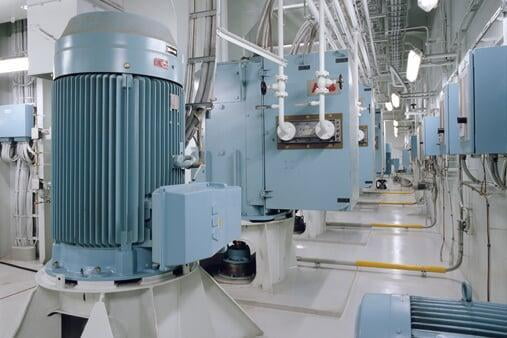Energy Efficiency
Arcoflex monitoring incorporates and complex ecosystem of IoT-based sensors over a wide variety of energy-using systems. These sensors report to decision making logic that helps with the more efficient use or distribution of energy as well as providing hard data for compliance based reporting. This can include absolute temperature levels as well as the pull-down rate from body temperature to storage temperature. The monitoring points shown below combine in the following ways:
- Heat Exchange monitoring measures the energy effectiveness of the pre-chill systems. Pre-chill and vat-chill systems have different costs and this metric helps identify which system is taking the heat loading.
- Milk temperature and vat temperature monitor help establish when temperature targets are met, at what speed they were met and then how much energy the vat consumes maintaining those targets. This metric is used to verify changes to the pre-chill systems.
- Ambient condition monitoring is used to justify or prevent cooling tower usage or to point to reasons why pre-chill systems might be consuming more energy than normal. This helps identify when it is equipment that is going out of specification or a natural occurrence.
- Hot water systems are monitored to ensure they are heating efficiently and to correct temperature. We can additionally control when such heating takes place so that unnecessary energy wastage is prevented. Other factors monitoring include hot water consumption patterns and availability for washing cycles.
- Monitoring solar energy input is vital to ensure that daytime storage systems (cold or hot) are turned off when there is insufficient solar to run them. If mains is required, it can be delayed until night rate is available unless emergency conditions prevail. In parallel with this, we monitor for unused available solar that can be directed into such storage systems or mechanical support such as crushers and pumps.
- Bore water temperatures are monitored so that we can reduce additional energy overheads trying to cool excessively warm water. Equally, this metric can help explain spikes in energy costs, allowing the site to consider different sources of water when the bore is too warm.
- All energy consumption can be tracked and then comparisons made with historical usage. This points to overall efficiency gains, cost decisions and the impact of new energy saving measures.
- Motor health is monitored to ensure they are operating to correct specification and not drawing excessive power. These systems are thus pre-emptive in nature and reduce the cost risk of catastrophic breakdown.
The light sensor can provide us with two important metrics:
- It can measure the absolute amount of solar possible if everything is in tip-top working order. As long as it is kept clean, it is a very low cost and effective way to know how much energy the solar array should be producing. We calibrate the sensor to your PV array at the start and then motor solar output against what we think should be generated.
- It can be used to detect cloudy days (solar availability) and thus help isolate energy consumption by storage systems that would otherwise be drawn from the grid. Some sites use this to allow equipment (like crushers and tank refill pumps) to operate on excess solar when they would otherwise only run off peak. It is another part of the decision making system, often in tandem with outputs from the solar array.
The equipment we are explicitly monitoring we can tell exactly the energy consumption and the energy usage pattern (time of day, event based etc). ‘exact’ should be within +/- 5% of the true figure but usually, this is good enough for comparative purposes. This will aid in a before and after reporting process. We could monitor an exact amount but it requires a few more sensors to achieve this accurately.

